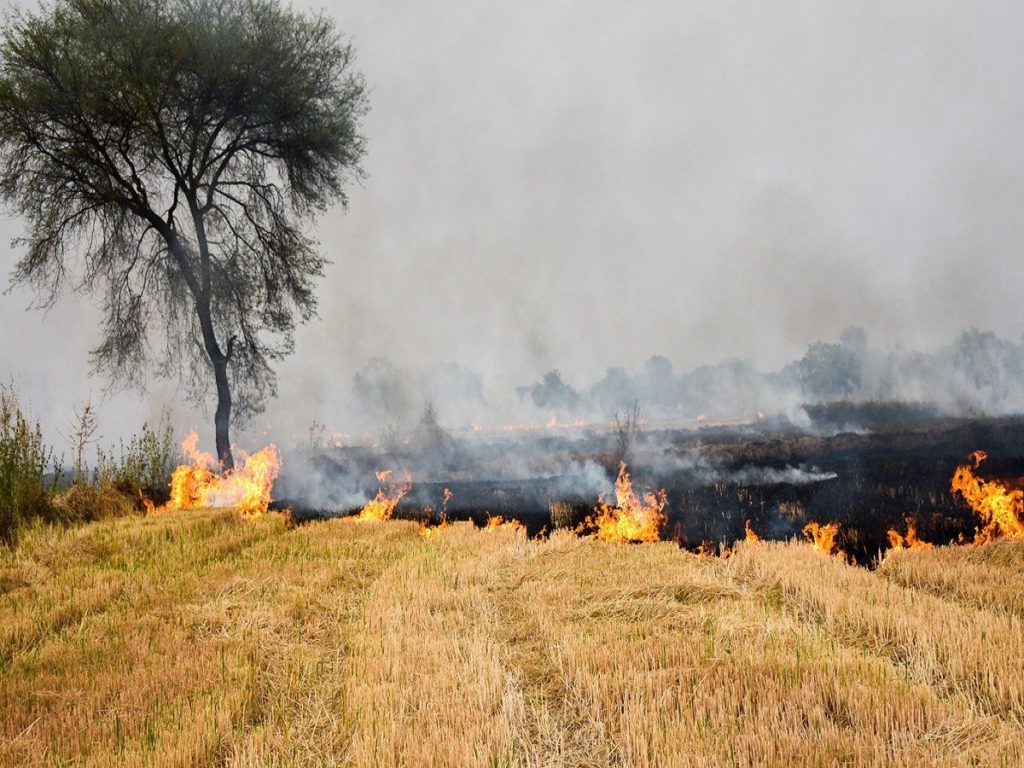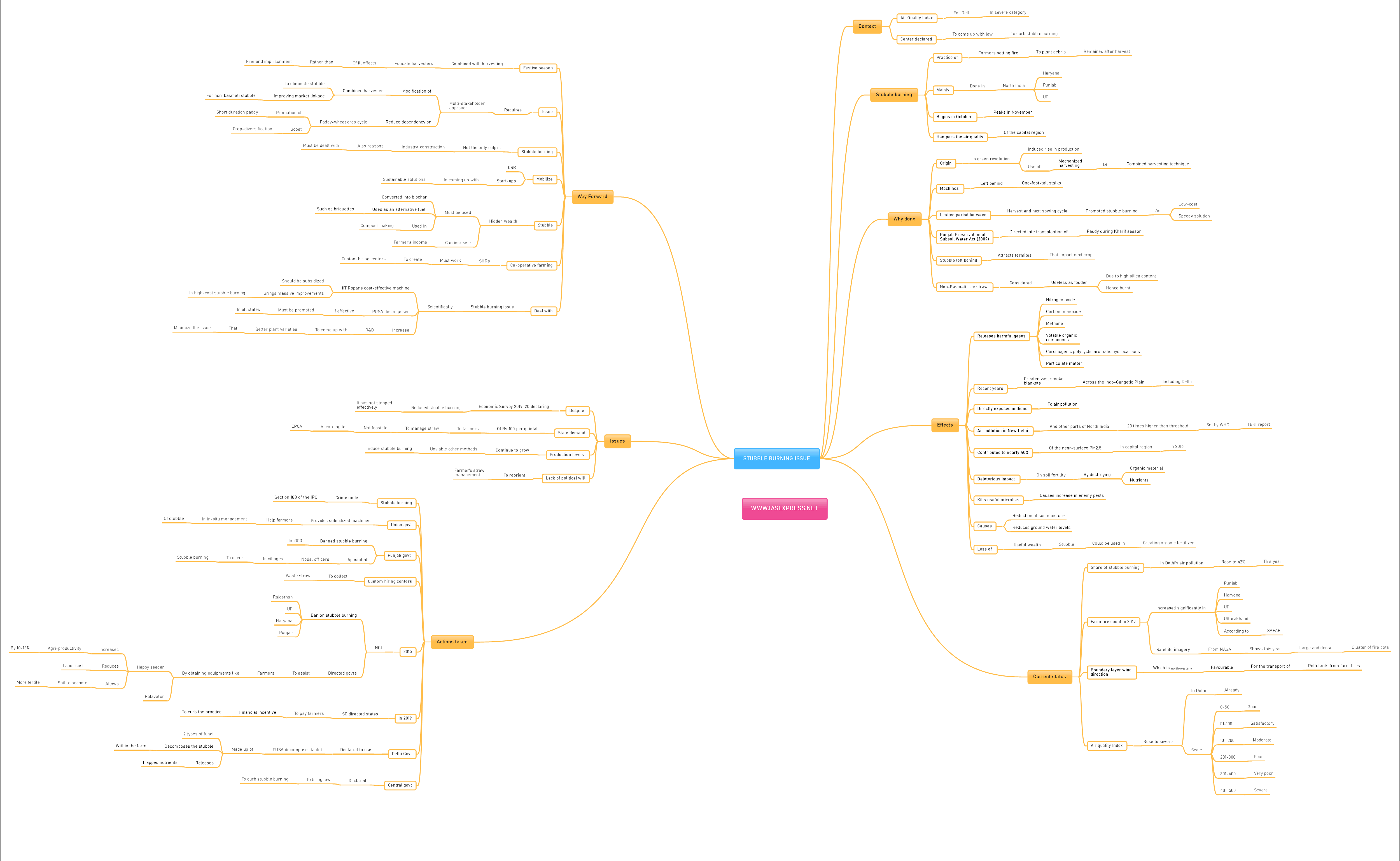Stubble Burning and Air Pollution in Delhi

As yet another winter convenes, the Delhi air pollution issue once again has come to discussion. The failure of successive years to contain air pollution in Delhi and its relation to the stubble burning practices in adjoining states has been discussed again and again with no proper solution in sight. The AQI in the national capital entered the ‘severe’ category in the first week of November. In this article, we will discuss the issue of stubble burning in Detail.
This topic of “Stubble Burning and Air Pollution in Delhi” is important from the perspective of the UPSC IAS Examination, which falls under General Studies Portion.
What is stubble burning?
- Stubble burning refers to the practice of farmers setting fire to plant debris that remain in farms after harvest.
- It has been used in Punjab and Haryana for a long time now to clear the fields to prepare it for winter sowing. Stubble burning is practiced predominantly by farmers in north India.
- It begins in October and the stubble burning peaks in November. The practice hampers the air quality of the capital region very badly as the thick smog overtakes its air to the level that is unbearable.
Why stubble burning is preferred by the farmers?
- Before the 1980s, farmers used to till the remaining debris back into the soil after harvesting the crops manually.
- The origin of stubble burning can be traced to the advent of the Green Revolution and mechanized
harvesting, which utilized the combined harvesting technique. - The Green Revolution increased greatly rice and wheat production, which simultaneously increased stubble post-harvest. However, the popular combined harvesting technique was not efficacious, as machines left behind one-foot-tall stalks.
- This prompted stubble burning as a low-cost and speedy solution available to farmers due to the limited time period of 20 25 days between harvesting one crop and sowing another.
- Laws like the Punjab Preservation of Subsoil Water Act (2009) which directed late transplanting of paddy during Kharif season left farmers with little time between harvesting and next sowing. The only feasible option for the farmers is to burn the leftovers.
- Also, if the stubble is left in the fields, it increases the attacks by termites on the next crop and decreases its output.
- The rice straw in the case of non-Basmati rice is considered useless as fodder due to its high silica content. So, farmers have no other use for the stack so they burn it.
- So, stubble burning gives farmers a cheap, quick, and easy way to clear the fields for the next crop cycle.
What are the effects of Stubble burning?
- The stubble burning process which is seen as an easy way out causes many problems. Important of them are the following:
- It releases harmful gases including nitrogen oxide, carbon monoxide, methane, Volatile organic compounds, carcinogenic polycyclic aromatic hydrocarbons, and particulate matter (PM2.5 and 10) into the atmosphere.
- In recent years, this practice has created vast smoke blankets across the Indo-Gangetic Plain and numerous neighbouring States, including Delhi.
- This directly exposes millions of people to air pollution. As per TERI (The Energy and Resources Institute), in 2019 the air pollution in New Delhi and other parts of north India was 20 times higher than the safe threshold level as prescribed by the World Health Organization.
- Crop burning contributed to nearly 40% of the near-surface PM2.5 in the capital region in 2016 which saw one of New Delhi’s worst pollution episodes.
- Stubble burning also has a deleterious impact on soil fertility by destroying organic material and nutrients from the soil. The heat penetrates into soil killing useful microbes.
- Stubble burning also causes an increase in enemy pests due to the killing of useful microorganisms.
- Stubble burning causes a reduction of soil moisture and also reduces groundwater levels in the region.
- Apart from these direct impacts it also leads to loss of useful ‘wealth’ that is stubble. Stubble may be useful in creating high-grade organic fertilizer by mixing it with cow dung and some enzymes.
What is the current status of stubble burning in the region?
- According to a central government air quality monitoring agency, the share of stubble burning in Delhi’s pollution rose to 42% this year.
- The Ministry of Earth Sciences’ air quality monitor, SAFAR, said the farm fire count in Punjab, Haryana, Uttar Pradesh, Uttarakhand, and neighbouring areas increased significantly and stood at 4,135 till October 2020.
- SAFAR said the boundary layer wind direction is north-westerly — favourable for the transport of pollutants from farm fires.
- satellite imagery from NASA recently showed that a large, dense cluster of fire dots is covering Punjab and parts of Haryana and Uttar Pradesh.
- The Air quality index for Delhi has risen to a severe category already.
- An AQI reading between zero and 50 is termed “good”, between 51 and 100 is termed “satisfactory”, between 101 and 200 is “moderate”, between 201 and 300 is “poor”, between 301 and 400 is “very poor”, and 401 and 500 is considered “severe”.
What has been done till now to contain the issue?
- The Union and state governments have been working incessantly to contain stubble burning so as to contain the air pollution.
- Section 188 of the IPC makes stubble burning a crime. It also an offense under the Air (prevention and control of pollution) Act, 1981.
- The Union government provides subsidized machines that help farmers in in-situ management by tilling the stubble back into the soil.
- In 2013, stubble burning was banned by the Punjab government. In 2015, the National Green Tribunal imposed a ban on stubble burning in Rajasthan, Uttar Pradesh, Haryana, and Punjab and directed the government to assist farmers by obtaining equipment like happy seeder and rotavator.
- The Punjab and Haryana government also provides straw management machines to deal with the issue.
- As per a study by the International Maize and Wheat Improvement Centre, the application of happy seeders and super SMS machines can improve agricultural productivity by 10% to 15% while reducing labor costs and allowing the soil to become more fertile.
- In 2019, the Supreme Court directed the governments of Haryana, Punjab, and Uttar Pradesh to pay farmers a financial incentive to curb the practice.
- The Punjab government-appointed nodal officers in villages to check stubble burning.
- Recently, the union government has declared that it will bring a law to curb stubble burning. Following that the SC suspended its earlier decision to have a one-man committee led by former justice Madan Lokur to monitor stubble burning
- The Delhi government recently decided to use PUSA Decomposer tablets made with seven types of fungi. It decomposes the stubble within the farm and also releases trapped nutrients in the straw into the soil and thus enrich it for the next crop.
What are the issues that still hindering better management of the stubble burning issue?
- Despite the Economic Survey 2019-20 stating that the stubble burning issue, this year again the capital’s air pollution.
- As seen above the stubble burning is coming to peak even before November end and Delhi air has touched severe condition on SAFAR.
- The state’s demand of Rs. 100 per quintal to farmers for managing the paddy straw without burning. However, the Environmental Pollution Control Authority has said that this method would not be viable.
- The production levels have increased and it is unviable for farmers to use other methods to do away with the huge stubble.
What can be done to address the issue effectively?
- With the festive season colliding with the harvest period this year, the air pollution levels are bound to increase. Rather than imposing fines or creating rigid statutory policies, it is important to educate the harvesters about the consequences of their actions.
- Effective policies to holistically tackle air pollution will have to be multi-stakeholder and multi–disciplinary in approach.
- The first nail on the head would be to reduce the dependency on the typical paddy-wheat crop cycle through initiatives such as the promotion of short duration paddy, boosting crop diversification through minimum support price for alternate crops, and raising awareness among farmers about alternative crop options and associated economic and environmental benefits.
- However, these are medium-term to long-term measures. Immediate short-term measures should include modification of combined harvester to eliminate stubble and improving market linkage for the problematic non-basmati stubble.
- Along with unabated stubble burning, industrial and construction activities are to blame for air pollution in Delhi and NCR. The corporate social responsibility funds and start-ups must be mobilized to provide technical solutions.
- The most appropriate way to tackle stubble burning is to deal with it in a scientific way. IIT Ropar’s cost-effective machine can be a massive improvement on high-cost stubble management. Government should provide subsidies to farmers to buy these machines.
- Stubble can be used as an alternative fuel such as briquettes, which can also increase a farmer’s income.
- Stubble can be converted into biochar, which can be used as a fertilizer, by burning it in a kiln.
- Co-operative societies of farmers, self-help groups, registered farmers societies or farmers groups, private entrepreneurs for establishment of farm machinery banks or custom hiring centers need to be developed.
- The state and central government could draw policies and allocate funds to local bodies to help the farmers build compost plants for stubble on application.
- In the longer term, long-duration paddy varieties can be replaced with shorter duration varieties, allowing enough time for the paddy stubble to decompose.
- The government must invest in agricultural research and development come up with alternative methods of curbing stubble burning.
Conclusion
The issues of the city of Delhi which gets throttled under the siege of polluted air and smoke every winter and farmer’s ability to deal with stubble are both equally important. The government must come up with an innovative and effective plan to address the issue of stubble burning, a plan that does not burden farmers and makes them culprits but makes them ready contributors to minimize the pollution of Delhi.
Practice Question for Mains
The issue of Delhi’s pollution cannot be solved just by making farmers culprit. They must be empowered to contribute. Comment (250 words)


